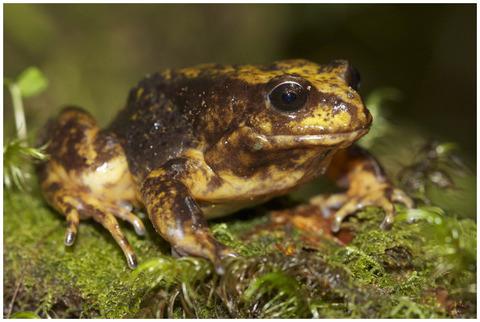当前位置:
X-MOL 学术
›
Anim. Conserv.
›
论文详情
Our official English website, www.x-mol.net, welcomes your
feedback! (Note: you will need to create a separate account there.)
Indirect terrestrial transmission of amphibian chytrid fungus from reservoir to susceptible host species leads to fatal chytridiomycosis
Animal Conservation ( IF 2.8 ) Pub Date : 2020-12-29 , DOI: 10.1111/acv.12665 Thomas J. Burns 1 , Ben C. Scheele 2 , Laura A. Brannelly 3 , Nick Clemann 4 , Deon Gilbert 5 , Don A. Driscoll 1
Animal Conservation ( IF 2.8 ) Pub Date : 2020-12-29 , DOI: 10.1111/acv.12665 Thomas J. Burns 1 , Ben C. Scheele 2 , Laura A. Brannelly 3 , Nick Clemann 4 , Deon Gilbert 5 , Don A. Driscoll 1
Affiliation

|
The amphibian chytrid fungal pathogen (Batrachochytrium dendrobatidis, henceforth Bd) has had a devastating impact on biodiversity, causing the decline or extinction of over 500 amphibian species. Yet, our understanding of Bd transmission pathways remains incomplete, in particular for host species with weak aquatic associations, and between reservoir and susceptible host species. We examined Bd transmission from a potential reservoir host to a potentially susceptible critically endangered host; directly assessing the capacity of the former to transmit Bd, and the susceptibility of the latter as a Bd host. Using cohousing versus sequential use of the same enclosure by the two species, we distinguished the effects of direct versus indirect (environmental) transmission. Our study provides clear evidence that both direct and indirect terrestrial transmission from a reservoir to susceptible host species results in fatal chytridiomycosis. Transmission mode had no effect on overall morbidity or disease progression in the susceptible species. Our results demonstrate that reservoir and susceptible hosts do not need to be in the same place at the same time, or within an aquatic environment for transmission to occur. Our demonstration of indirect terrestrial transmission from a reservoir to susceptible host identifies mechanisms by which Bd may drive ongoing declines in populations where the pathogen is now endemic. Identifying these transmission pathways is important for understanding long-term extinction vulnerability of remnant populations of declining species challenged by disease.
中文翻译:

两栖类壶菌真菌从宿主到易感宿主物种的间接陆地传播导致致命壶菌病
两栖类壶菌真菌病原体(Batrachochytrium dendrobatidis,以下简称Bd)对生物多样性产生了破坏性影响,导致 500 多种两栖类物种减少或灭绝。然而,我们对Bd传播途径的理解仍然不完整,特别是对于水生关联较弱的宿主物种以及水库和易感宿主物种之间的宿主物种。我们检查了Bd从潜在宿主宿主到潜在易感的极度濒危宿主的传播;直接评估前者传输Bd的能力,以及后者作为Bd的易感性主持人。使用同居与两个物种连续使用相同的围栏,我们区分了直接与间接(环境)传播的影响。我们的研究提供了明确的证据,表明从水库到易感宿主物种的直接和间接地面传播都会导致致命的壶菌病。传播模式对易感物种的总体发病率或疾病进展没有影响。我们的结果表明,宿主和易感宿主不需要同时在同一地点或在水生环境中才能发生传播。我们对从水库到易感宿主的间接地面传播的演示确定了Bd 的机制可能会导致病原体现在流行的人口持续下降。确定这些传播途径对于了解受到疾病挑战的衰退物种残余种群的长期灭绝脆弱性非常重要。
更新日期:2020-12-29
中文翻译:

两栖类壶菌真菌从宿主到易感宿主物种的间接陆地传播导致致命壶菌病
两栖类壶菌真菌病原体(Batrachochytrium dendrobatidis,以下简称Bd)对生物多样性产生了破坏性影响,导致 500 多种两栖类物种减少或灭绝。然而,我们对Bd传播途径的理解仍然不完整,特别是对于水生关联较弱的宿主物种以及水库和易感宿主物种之间的宿主物种。我们检查了Bd从潜在宿主宿主到潜在易感的极度濒危宿主的传播;直接评估前者传输Bd的能力,以及后者作为Bd的易感性主持人。使用同居与两个物种连续使用相同的围栏,我们区分了直接与间接(环境)传播的影响。我们的研究提供了明确的证据,表明从水库到易感宿主物种的直接和间接地面传播都会导致致命的壶菌病。传播模式对易感物种的总体发病率或疾病进展没有影响。我们的结果表明,宿主和易感宿主不需要同时在同一地点或在水生环境中才能发生传播。我们对从水库到易感宿主的间接地面传播的演示确定了Bd 的机制可能会导致病原体现在流行的人口持续下降。确定这些传播途径对于了解受到疾病挑战的衰退物种残余种群的长期灭绝脆弱性非常重要。











































 京公网安备 11010802027423号
京公网安备 11010802027423号